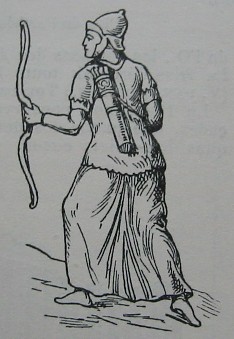
Arsaces I was the first king of Parthia, ruling from 247 BC to 217 BC, as well as the founder and eponym of the Arsacid dynasty of Parthia. The leader of the Parni, one of the three tribes of the Dahae confederacy, Arsaces founded his dynasty in the mid-3rd century BC when he conquered the satrapy of Parthia from Andragoras, who had rebelled against the Seleucid Empire. He spent the rest of his reign consolidating his rule in the region, and successfully stopped the Seleucid efforts to reconquer Parthia. Due to Arsaces' achievements, he became a popular figure amongst the Arsacid monarchs, who used his name as a royal honorific. By the time of his death, Arsaces had laid the foundations of a strong state, which would eventually transform into an empire under his great-grandnephew, Mithridates I, who assumed the ancient Near Eastern royal title of King of Kings. Arsaces was succeeded by his son Arsaces II.

The Parni or Aparni were an East Iranian people who lived around the Ochus (Tejen) River, southeast of the Caspian Sea. It is believed that their original homeland may have been southern Russia from where they emigrated with other Scythian tribes. The Parni were one of the three tribes of the Dahae confederacy.

Hyrcania is a historical region composed of the land south-east of the Caspian Sea in modern-day Iran and Turkmenistan, bound in the south by the Alborz mountain range and the Kopet Dag in the east.
Epiphanes, meaning "God Manifest" or "the Glorious/Illustrious", is an ancient Greek epithet borne by several Hellenistic rulers:
Orodes is the Latinized form of a male given name of Iranian origin popular among Parthians. People bearing the name include:

Gotarzes II was king of the Parthian Empire from 40 to 51. He was an adopted son of Artabanus II. When his father died in 40, his brother Vardanes I was to succeed to the throne. However, the throne was seized by Gotarzes II. Gotarzes II eventually was able to gain control of most of Parthia forcing Vardanes to flee to Bactria. With the death of Vardanes in c. 46, Gotarzes II ruled the Parthian Empire until his death. Gotarzes II was succeeded by his uncle Vonones II.
Arsaces or Arsakes is the eponymous Greek form of the dynastic name of the Parthian Empire of Iran adopted by all epigraphically attested rulers of the Arsacid dynasties. The indigenous Parthian and Armenian form was Parthian: 𐭀𐭓𐭔𐭊Aršak and Old Armenian: ԱրշակAršak.
The Parthian language, also known as Arsacid Pahlavi and Pahlawānīg, is an extinct ancient Northwestern Iranian language once spoken in Parthia, a region situated in present-day northeastern Iran and Turkmenistan. Parthian was the language of state of the Arsacid Parthian Empire, as well as of its eponymous branches of the Arsacid dynasty of Armenia, Arsacid dynasty of Iberia, and the Arsacid dynasty of Caucasian Albania.

Pahlavi is a particular, exclusively written form of various Middle Iranian languages. The essential characteristics of Pahlavi are:

Relations between the Roman and Iranian states were established c. 92 BC. It was in 69 BC that the two states clashed for the first time; the political rivalry between the two empires would dominate much of Western Asia and Europe until 628. Initially commencing as a rivalry between the Parthians and Rome, from the 3rd to mid-7th centuries the Roman Empire and its rival Sassanid Persia were recognized as two of the leading powers in the world.

Aria was an Achaemenid region centered on the city of Herat in present-day western Afghanistan. In classical sources, Aria has been several times confused with the greater region of ancient Ariana, of which Aria formed a part.

The Parthian Empire, also known as the Arsacid Empire, was a major Iranian political and cultural power in ancient Iran from 247 BC to 224 AD. Its latter name comes from its founder, Arsaces I, who led the Parni tribe in conquering the region of Parthia in Iran's northeast, then a satrapy (province) under Andragoras, who was rebelling against the Seleucid Empire. Mithridates I (r. c. 171–132 BC) greatly expanded the empire by seizing Media and Mesopotamia from the Seleucids. At its height, the Parthian Empire stretched from the northern reaches of the Euphrates, in what is now central-eastern Turkey, to present-day Afghanistan and western Pakistan. The empire, located on the Silk Road trade route between the Roman Empire in the Mediterranean Basin and the Han dynasty of China, became a center of trade and commerce.

Andragoras was an Iranian satrap of the Seleucid provinces of Parthia and Hyrcania under the Seleucid rulers Antiochus I Soter and Antiochus II Theos. He later revolted against his overlords, ruling independently from 245 BC till his death.

Parthia is a historical region located in northeastern Greater Iran. It was conquered and subjugated by the empire of the Medes during the 7th century BC, was incorporated into the subsequent Achaemenid Empire under Cyrus the Great in the 6th century BC, and formed part of the Hellenistic Seleucid Empire after the 4th-century BC conquests of Alexander the Great. The region later served as the political and cultural base of the Eastern Iranian Parni people and Arsacid dynasty, rulers of the Parthian Empire. The Sasanian Empire, the last state of pre-Islamic Iran, also held the region and maintained the seven Parthian clans as part of their feudal aristocracy.

The Seleucid–Parthian wars were a series of conflicts between the Seleucid Empire and Parthia which resulted in the ultimate expulsion of the Seleucids from Iran and the establishment of the Parthian Empire. The wars were caused by Iranian tribes migrating into Central Asia and the inability of the Seleucids to properly defend or hold together their vast empire.

Parthian art was Iranian art made during the Parthian Empire from 247 BC to 224 AD, based in the Near East. It has a mixture of Persian and Hellenistic influences. For some time after the period of the Parthian Empire, art in its styles continued for some time. A typical feature of Parthian art is the frontality of the people shown. Even in narrative representations, the actors do not look at the object of their action, but at the viewer. These are features that anticipate the art of medieval Europe and Byzantium.
Persian war of succession may refer to:
This page is based on this
Wikipedia article Text is available under the
CC BY-SA 4.0 license; additional terms may apply.
Images, videos and audio are available under their respective licenses.











